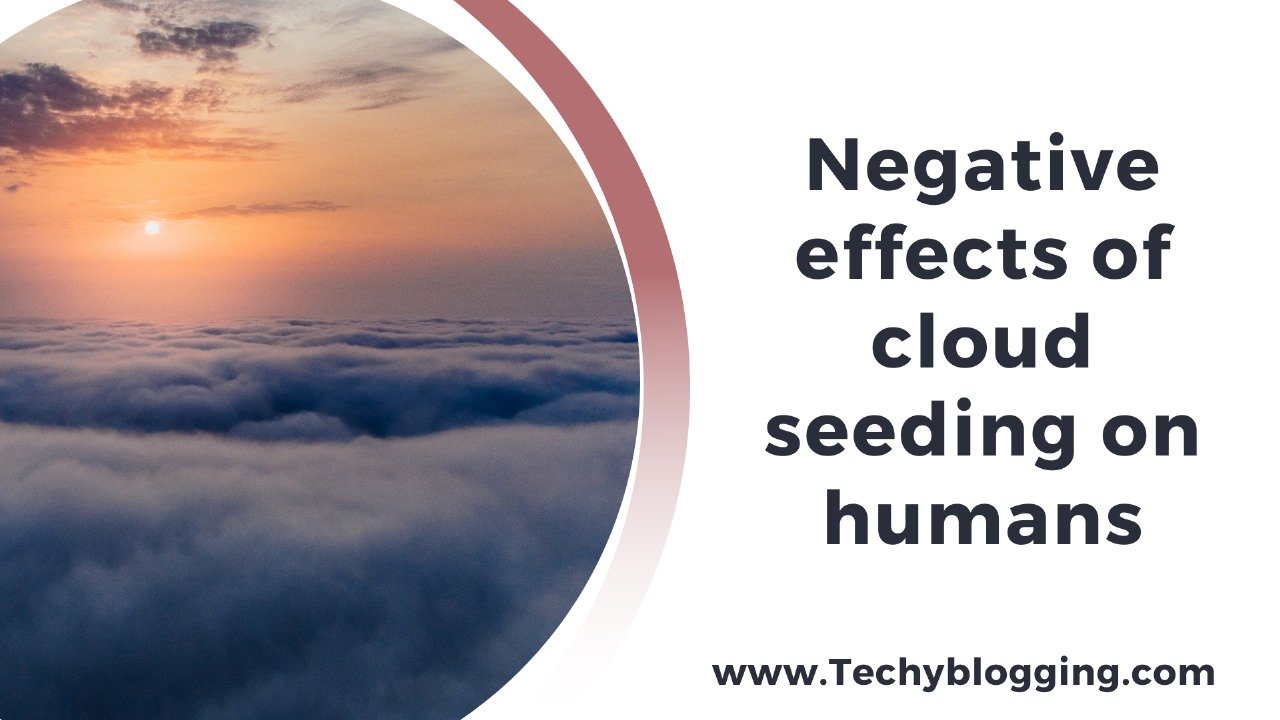Negative effects of cloud seeding on humans. Cloud seeding is a kind of modification to the weather. Is design to improve the quantity of rain by releasing chemicals into the air. Although its main goal is to boost the amount of rainfall and ease drought, it’s vital to study the possible adverse effects. That cloud seeding can have on the human body and natural environment. This article examines the negative effects of cloud seeding such as health risk and environmental concerns, as well as moral dilemmas and socio-economic consequences.
Understanding Cloud Seeding
What is Cloud Seeding?
Cloud seeding refers to the introduction of substances such as silver iodide or sodium chloride or ice pellets to clouds in order to promote rain. In changing the microphysical properties of clouds, the seeding agents may encourage the formation of droplets which can result in increased rain. The technology is frequently used for agriculture as well as in water resource management as well as to reduce the effects of drought.
Historical Context
Cloud seeding goes back to the 1940s and began with research conducted by scientists such as Vincent J. Schaefer. Through the years the idea has taken off in a number of countries, including China, the United States, China, as well as Australia due in part to growing concerns about water shortage.
Health risks associated with cloud Seeding

Chemical Exposure
One of the main issues with cloud seeding is that it makes use of chemical compounds, including silver Iodide. Although some argue they are safe at low levels research suggests risk to the health of people.
Respiratory Issues
The inhalation of particles from fines may cause respiratory discomfort in particular for people who have asthma or other conditions that are preexisting. Cloud seeding may introduce particles of particles into the air, which can cause problems with air quality and create dangers to health for people with weakened immune systems.
Allergic Reactions
A few people might experience allergies to certain chemicals utilized for cloud seeding. It can be a moderate respiratory discomfort to extreme reaction to allergens. Particularly in regions that cloud seeding takes place often.
Long-Term Health Effects
The long-term consequences of the exposure to materials that seed clouds are not fully understood. Although the immediate effects may be small but the cumulative effects from repeated exposures may lead to health problems over the course of time. It is essential to research and be aware of the risks that could arise.
Environmental Concerns
Disruption of Local Ecosystems
Cloud seeding could have unintended impacts on local ecosystems. Changes in precipitation patterns could alter the equilibrium of ecosystems. Impacting the fauna and flora that has been adapted to climatic conditions specific to.
Water Quality Issues
The increased rainfall caused by cloud seeding may result in discharges. That carry contaminants and other chemicals to the local waters bodies. It can lead to deterioration of water quality, causing harm to living things in the water and drinking supply.
Climate Change Implications
Cloud seeding is usually thought of as an easy solution to water shortage. However it could inadvertently cause changes in the climate. Changes in precipitation patterns could disrupt local climates and could lead to worsening droughts elsewhere and changing the weather patterns worldwide.
Ethical Dilemmas
The game of God by interacting with nature
One of the biggest moral concerns with cloud seeding concerns the ethical implications that are associated with manipulating natural phenomena. The argument is that human involvement on weather patterns may cause unintended results. Which could challenge our perception of the nature’s equilibrium.
Consent and Equity Issues
Cloud seeding raises questions about consent and equity. People who are affected by the cloud seeding process might not be able to participate in the decisions that affect their health or environment. Lack of transparency may cause distrust and conflict between local residents.
Potential for Conflicts
In the face of regions and countries facing problems with water shortages, the battle for water resources could increase. Cloud seeding may increase tensions between adjacent areas or countries. In particular when one region experiences an rise in rains at the expense of the other.
Socio-Economic Impacts
Economic Disparities
Cloud seeding projects typically require significant investment. This could take funds away from more important fields like healthcare or education. It can result in economic gaps and in particular, regions that are underfunded where there is a lower chance of benefiting from the initiatives.
Impact on Agriculture
Cloud seeding is intended to improve agricultural production but its efficacy isn’t for sure. Farmers might decide to invest in cloud seeding in the expectation of more rainfall and then be disappointed when the payoff are not as expected. This could cause economic strain on farming communities.
Community Displacement
In certain instances cloud seeding initiatives may result in displacement of communities. When areas are affected by changes in rainfall patterns. People could be required to move which can disrupt their lives and their cultural connections.
Conclusion
Cloud seeding is the possibility of a solution to dryness and water supply however. You must take into consideration the adverse effects on health of the human population as well as the environment. social stability. Long-term effects of manipulating conditions of the weather remain unclear which is why it is essential to have a complete comprehension of the dangers involved.
Prior to widespread acceptance of cloud seeding methods the scientists and policy makers need to conduct extensive studies, discussions about ethics, and consultations with the community. The balance between the advantages of more precipitation against the possible negative consequences is vital to ensure security and wellbeing of the affected population.
While we work through the complexity of the climate and water issues It is crucial to consider cloud seeding as well as similar technology carefully, and ensure that we are focusing on the wellbeing of the planet as well as its residents.




